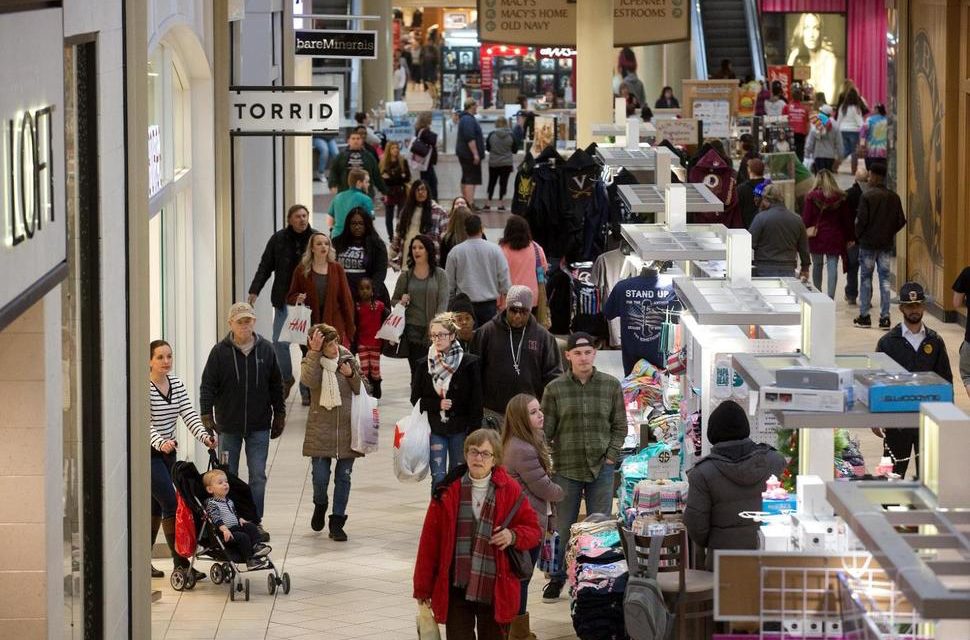FILE – In this Tuesday, Dec. 26, 2017, file photo, shoppers take advantage of discounts and slashed post-Christmas prices at Valley View Mall in Roanoke, Va. The National Retail Federation said Friday, Jan. 12, 2018, that holiday sales reached $691.9 billion as shoppers stepped up their spending in the wake of a better economy. (Erica Yoon/The Roanoke Times via AP, File) The Associated Press
Better-than-expected holiday season doesn’t erase pressure on retailers.
NEW YORK (AP) — Retailers are riding high after ebullient U.S. consumers shopped at the healthiest pace in more than a decade over the holiday season. But merchants can’t afford to rest easy.
None of the pressure on them has eased, and the fight for customers’ attention will only intensify. Retailers trying to hold their own against an expanding Amazon will have to keep sprucing up their stores and investing in the quick delivery that shoppers want. Those kinds of moves may bite into their profits, but they’ll save money from tax changes.
Store closures, already at a post-recession high, could keep coming. And in a sign of just how critical it is that stores get delivery right, Walmart’s Sam’s Club says it’s converting some of the locations it’s closing into e-commerce fulfillment centers. Companies trying to leverage their stores may think about following.
Several retailers including Target, Kohl’s, and J.C. Penney reported solid holiday sales gains. Retail sales rose 0.4 percent in December, the Commerce Department said Friday, after a 0.9 percent surge in November. Those figures include online sales.
Spending for the two months combined was the best since 2005, according to IHS Markit, an economic consulting firm. Sales at home and garden stores and at restaurants and bars did well.
And the National Retail Federation trade group said that by its measure, which exclude sales from autos, gas and restaurants and includes non-store sales like those from catalogs, holiday spending rose a better-than-expected 5.5 percent. That sailed past the group’s original projections and marked the biggest increase since the 5.2 percent gain in 2010. Online shopping, which is included in the results, increased 11.5 percent.
“It was certainly a vibrant season,” said Jack Kleinhenz, chief economist at the NRF. “This will charge the batteries of consumption for 2018.”
Kleinhenz believes the tax changes will help to bump up spending this year. Stores will be fighting hard for that spending, as Amazon scoops up much of the growth. Retailers have been re-examining ways to use their stores.
Target has said that 70 percent of its online sales in November and December were fulfilled by stores that were used either to ship online orders or as pickup points for customers who ordered online. The company is now shipping online orders from 1,400 of its 1,800 stores to offer faster delivery.
Tom McGee, president and CEO of the International Council of Shopping Centers, says of those holiday shoppers polled who ordered goods online and picked them up at the store, 90 percent bought more once they were at the stores.
And retailers other than Amazon are trying to expand their options to offer same-day delivery. Macy’s and Best Buy are using startups like Deliv. Target recently acquired Shipt, which will mean same-day delivery services from about half of its stores early this year. And Walmart bought a startup called Parcel as it aims to offer same-day delivery to New Yorkers.
And Walmart, which has been buying smaller online companies and trying to strengthen its hand against Amazon, is converting about 10 of the 63 Sam’s Clubs it is closing into e-commerce centers.
“As retail continues to evolve, we believe these physical assets will be subject to stricter scrutiny as to their role in each company’s overall strategic plan, with ‘pruning’ and re-allocation such as Walmart is doing with Sam’s the rule rather than the exception,” said Charles O’Shea, Moody’s lead retail analyst.
It’s not something every retailer can do. Ken Perkins, president of research firm Retail Metrics, believes that only big-box retailers could convert stores into fulfillment centers because of the sheer size needed.
A lot of pruning has already taken place in a tumultuous year for retailers. Fifty retailers filed for bankruptcy last year, according to S&P Global Market Intelligence. Many of them were very small companies but they included well-known brands like Payless ShoeSource and Toys R Us.
The number of announced store closures came to nearly 7,000, according to Fung Global Retail & Technology, which exceeded the 2008 peak of 6,200. Perkins expects the number of store closures should be similar this year compared to last year. The most dramatic store pruning will likely come from long-struggling chains like Sears Holdings Corp, which owns Kmart and Sears stores. The company keeps securing more funding while closing more stores to keep afloat.
Analysts are keeping an eye on retailers saddled with heavy debt loads because of leveraged buyouts. Among those on Moody’s watch list are Nine West Holdings, J. Crew and Bon-Ton Stores Inc. The Wall Street Journal, citing people familiar with the matter, reported Friday that Bon-Ton is continuing discussions with its debt holders as it gets ready for a likely bankruptcy as soon as February.
By ANNE D’INNOCENZIO and CHRISTOPHER RUGABER, AP Business Writers

